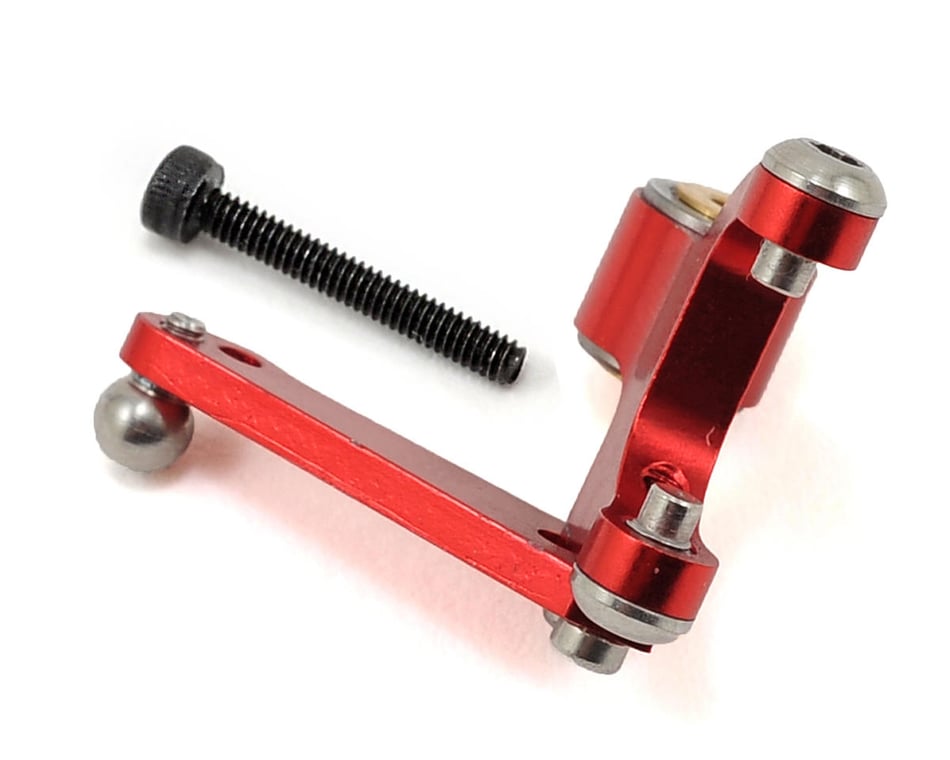
- Bell Crank Assembly
- Bell Cranks And Linkage
- Design Procedure Of Bell Crank Lever Pdf
- Bell Crank Lever Mechanism
Bell Crank Assembly
Design of lever involves determination of various dimensions of the lever for a specified load or output force required. For a specified load or output force desired, effort required can be calculated using principle of moments. Due to these forces, arms of the lever are subjected to. A bell-crank lever consists of a long arm, 8 1 2 in. Long, and a short arm 4 in. Long, at right angles to each other. Calculate the force to be applied at right angles to the end of the long arm to overcome a resistance of 40 lbf acting at 30° to the vertical of the short arm. Handlebar lever is rotated at an angle of 90. To push the brake block against the wheel rim 2 Figure 1: Typical example of a bell crank 2 2.0 Initial Load Case. Figure 2: CAD Model of In-line Bell crank thus the results are taken to be as Figure 2 shows the design of the in-line bell crank. The bell crank is expected to be made of steel.

Bell Cranks And Linkage
Design Procedure Of Bell Crank Lever Pdf
- Fornace, L.V.: Weight Reduction Techniques Applied to Formula SAE Vehicle Design: An Investigation in Topology Optimization (2006)Google Scholar
- Muhammad Sahail, B. Zainol Abidin.: Design and Development of a Bell Crank for Monoshock Front Suspension for Formula Varsity Race Car. Melaka, universiti teknikal malaysia melakaGoogle Scholar
- Borg, L.T., West, R.L., Ferris, J.B., Member, C., Merkle, M.A.: C.Member Borg_L_ETD_Copy_07-26-2009.pdf (2009)Google Scholar
- Dange, M.M.M., Zaveri, S. R., Khamankar, S.D.: International Journal on Recent and Innovation Trends in Computing and Communication Stress Analysis of Bell Crank Lever (2014)Google Scholar
- Zende, S.R., Shaikh, M.R., Dolas, D.R.: International Journal of Modern Trends in Engineering and Research Fillet Radius Optimization of Bell Crank Lever (1947)Google Scholar
- Patel, R.C., Sikh, S.S., Rajput, H.G.: Machine Design (1992–93)Google Scholar
- Chan, W.H., Chan, A.H.S.: Strength and reversibility of movement stereotypes for lever control and circular display. Int. J. Ind. Ergon. 37, 233–244 (2007)Google Scholar
- Allegrucci, L., Amura, M., Bagnoli, F., Bemabei, M.: Fatigue fracture of a aircraft canopy lever reverse. Eng. Fail. Anal. 16, 391–401 (2009)Google Scholar
- Liu, Y.: Recent innovations in vehicle suspension systems. Recent Pat. Mech. Eng. 1, 206–210 (2008)Google Scholar
- Gyllenskog, J.D.: Fatigue life analysis of T-38 aileron lever using a continuum damage approach. All Graduate Theses and Dissertations (2010)Google Scholar
- Jouaneh, M., Yang, R.: Modeling of flexure-hinge type lever mechanisms. Precis. Eng. 27(4), 407–418 (2003)Google Scholar
- Bos van den P.: Design of a Formula Student Race Car Spring-Damper System. Eindhoven, Technische Universiteit (2010)Google Scholar
- Emey, T., Chrysler, D.: Combination of topology and topography optimization for sheet metal structures. Altair Eng. Ger. AIAA 2000-4946Google Scholar
Bell Crank Lever Mechanism
Parametric design charts are proposed for the central-lever steering linkage, generated for simplified reference configuration mechanisms, the geometry of which is defined by only four parameters. This highlights the fact, yet not generally acknowledged, that the steering law ensured by a mechanism with adjacent central joints (known as bell crank mechanism), can be identically generated by a triple central joint variant of the same. Particular configurations are identified in which the length of the central lever does not affect the wheel-to-wheel transmission function of the mechanism, permitting a simplified synthesis for the cases in which the maximum stroke of the input member is imposed as a design specification.